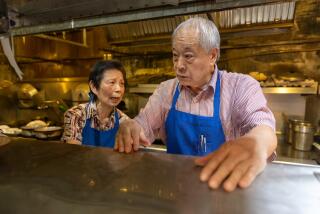The Lo Dynasty Lives On in London
- Share via
Once upon a time, the Chinese cookbook field was dominated by Kenneth Lo. Born in Fuzhou, China, in 1913, he had followed a variety of occupations before starting to write about food. By the time he died in 1995, Lo had produced more than a score of books, founded the Chinese Gourmet Club in London, where he lived, and opened a cooking school (Kenneth Lo’s Kitchen) and a restaurant called Memories of China.
Early on, Lo lamented the lack of authenticity in Chinese food outside of China. In “Peking Cooking” (Pantheon Books, 1971), he wrote, “In America ... the Chinese themselves had developed a special cuisine to suit the taste of the natives.” Although a very nice place, he observed, San Francisco “did seem a long way from Shanghai.” Lo had not visited that city since 1950, of course, and presumably the food had improved in the interim.
Londoners, meanwhile, were eating well. “Certainly London’s new Chinatown in Gerrard Street near Piccadilly is fiercely genuine,” Lo wrote in the same book. This resulted from the demands of a predominantly Chinese clientele and competition among chefs, a situation similar to that in the San Gabriel Valley today.
Jumping ahead 30 years, we have a new book, “Secrets From a Chinese Kitchen” (Pavilion, $27.50), written by Vivienne and Jenny Lo, his daughters. The sisters operate a restaurant on Eccleston Street in London, the Teahouse. Jenny Lo worked for years with her father, running the first Memories of China and also managing Kenneth Lo’s Kitchen. Their work speaks well for his high standards, although they write that they weren’t allowed in the kitchen as children and had to learn cooking from scratch after they left home.
As did their father, the Lo sisters have pursued Chinese regional cuisines to their sources. Their recipe for lamb in cumin sesame cream sauce comes from a Muslim restaurant in Tianjin. Fish-shaped breads are from Xinfan, a small town in Sichuan province, and home-style fried rice represents the cooking of their father’s native town of Fuzhou.
Food is quickly prepared at the Teahouse -- the ideal is for customers to be served in 15 minutes -- so the Los know how to cook conveniently. One of their recipes, pork spare ribs with black beans, may steam for an hour, but it takes only moments to combine the ingredients. Aside from water and oil for frying, eggplant with bean curd sauce requires only four ingredients, including cilantro for a garnish. But obviously it will take longer to produce at home what a restaurant can turn out in 15 minutes, taking advantage of prepared soup stocks and pre-chopped ingredients.
Some recipes date to Kenneth Lo’s era, including a spinach and radish salad that came from one of his friends, a seafood combination in wine sauce that was one of his favorite dishes and a fish omelet that was served in all the Lo restaurants.
The “secrets” theme is carried out in a blue box at the bottom of each recipe. These boxes contain some sort of (not necessarily secret) cooking tip, ingredient information or general comment.
The book is well worth buying for its content, but the format works against it. The type is abysmally small, pale and hard to read. The boxes of secrets, which seem gimmicky, are even harder to read, because various designs underlie and obscure the text.
So the challenge in using this book lies not in producing the recipes but in reading them. Trying to catch a quick glimpse of the next step when in the midst of a fast stir-fry would be next to impossible.
More to Read
Eat your way across L.A.
Get our weekly Tasting Notes newsletter for reviews, news and more.
You may occasionally receive promotional content from the Los Angeles Times.










